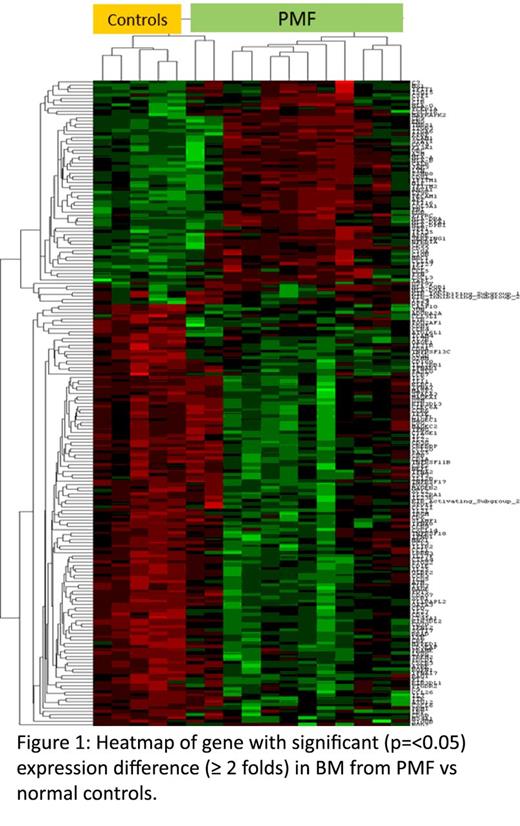Abstract
Background: Gene expression profiling studies have demonstrated aberrant expression of inflammatory response genes in myeloproliferative neoplasm (MPN) granulocytes and/or CD34+ cells. Our understanding of the immune response to primary myelofibrosis (PMF) hematopoietic stem cells and tissue-specific microenvironments is not complete due to a limited availability of bone marrow (BM) aspirates and fresh spleen samples from PMF patients. In order to overcome this obstacle, we utilized a novel approach with mRNA enrichment analysis which utilizes formalin fixed, paraffin embedded (FFPE) specimens of BM and spleen from PMF patients to identify immune and other microenvironment cell types and to construct pathway activation patterns.
Methods: We applied enzyme-free NanoString nCounter® PanCancer Immune Profiling Panel system (NanoString Technologies, Inc., Seattle, WA) consisting of 770 standard gene panel and 20 custom gene panel for identification of immune cells and assessing immunological milieus in the microenvironement of matched, archival FFPE spleen and BM samples from MPN patients.. Up to 500ng of RNA (at 100ng/ul) isolated from FFPE BM and/or spleen specimens from PMF patients was used for digital expression profiling in accordance with the manufacturer's protocol. The panel included 109 genes that define 24 immune cell types and populations, and 40 housekeeping genes that facilitate sample-to-sample normalization. Data analysis was performed using nSolver software 2.5 and the PanCancer Immune Profiling Advanced Analysis Module (v.1.0.22). Findings identified from the digital expression profiles on cells types were confirmed via immunohistochemical evaluation.
Results: Twenty-six archival FFPE tissue samples (13 BM and 13 spleen) obtained from PMF patients who had undergone therapeutic splenectomy and BM biopsy at the same time, and normal tissue controls, were analyzed as described previously (Liew et al 2015). Following data normalization, genes were selected based on P < 0.05 (unpaired t -test) and fold change > 2.0 differentially expressed mRNA levels in the BM (n=208) and spleen (n=108). These genes were distributed across several functional categories including: TNF superfamily (e.g. TNFRS13C, CD70, LTB), signal ligands (cytokine, chemokine) (e.g. JAK3, IFI16, SPP1), B and T cell functions (TIGIT, CXCR5, CXCL14), and cell adhesion (e.g. ITGB3). In supervised clustering of the significantly expressed genes, the first bifurcation of the dendrogram separated controls from PMF samples in both BM and spleen. Twenty-seven genes were significantly differentially expressed by both PMF BM and spleen, compared to control specimens. Interestingly, the PMF BM samples were further separated in a second bifurcation of the dendrogram into 3 subgroups, indicating immune transcriptional diversity within PMF samples (Figure 1). Further characterization of these subgroups and potential clinical relevance are being studied in a larger number of specimens in order to achieve statistical power.
Cell type analysis indicated a significant (P =<0.05) difference in activated CD4 T-cells, T helper-1 cells, CD8 T-cells, and B-cells across all BM and spleen samples. Macrophages (P =<0.001) were increased in the spleen, and neutrophils (P =0.01) were increased only in BM samples. A decrease in CD8-positive T-cells in PMF samples (p =0.009) was confirmed using immunohistochemistry with computer assisted image analysis. Heterogeneity of Tregs in PMF spleen samples (n=10) was further confirmed by immunohistochemistry (n-3).
Conclusions: Digital immune expression profiling coupled with immunohistochemistry is a novel approach for characterization of tumor microenvironment in fibrotic PMF marrow and spleen. Our preliminary findings indicate a consistent decrease in cytotoxic CD8 T-cells but varying expression of Tregs. In addition, we identified several genes in various immune functional categories within PMF patients that could potentially serve as therapy targets.
Hoffman:All Cells, LLC: Consultancy, Membership on an entity's Board of Directors or advisory committees; Promedior: Research Funding; Geron: Consultancy, Membership on an entity's Board of Directors or advisory committees. Salama:Promedior: Consultancy.
Author notes
Asterisk with author names denotes non-ASH members.


